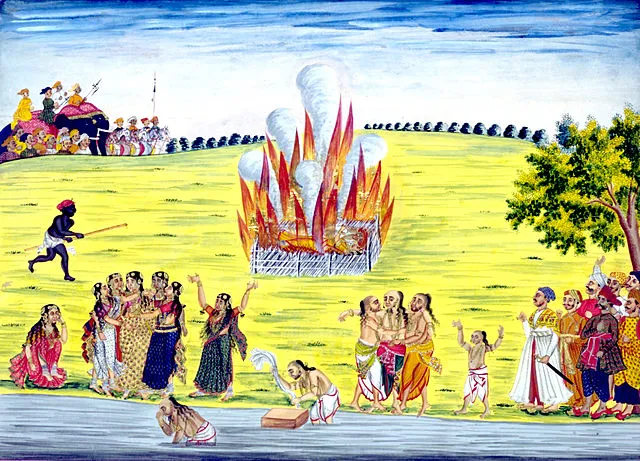(Photo: Practice of widow-burning or sati/suttee -painted circa 1800, source: Wikimedia)
From an Islamic viewpoint, Roy used the unitarian views of Persian Sufism as a vehicle to preach his reformative ideas to combat polytheism and criticizing crude Indian rituals such as voluntary or later forced wife-burning at husband funerals. (sati).*
Roy, Rabindranath Tagore’s father; sufism tolerance
Ram Mouhan Roy (Rāmmohan Rāy (1774–1833) was the leading reformist leader of Bengal, and indeed the whole of Hindu India in the early nineteenth century.
From early childhood, Roy was sent to a Muslim madrasa to be educated in Persian and Arabic, where he gained a perfect mastery of both languages.
Although born in a Brahman family, he even dressed like a Muslim and observed Islamic etiquette in both his private and public life.6

He became versed in classical Persian poetry, Muslim scholastic theology کلام (kalām), تفسیر (Qur’ānic exegesis), فقه (jurisprudence), and Islamic philosophy .5
He wrote his famous book تحفه الموحدین (Tuhfat al-Muwahhidin) in Persian.
The first of the key verses in his book, تحفه الموحدین (Tuḥfat al-muwaḥiddīin) are the following by Hafez:
جنگ هفتاد و دو ملّت همه را عذر بنه … چون ندیدند حقیقت رهِ افسانه زدند
This unitarian calling verse of Ḥāfiẓ quoted by Roy throughout his Persian writings: was the same verse also constantly on the tongue of Tagore’s father,
Roy’s treatise was concluded with:
مباش در پی آزار و هر چه خواهی کن … که در شریعت ما غیر از این گناهی نیست
Translation:
Cause no distress to one another, then go as you wish
For in our holy law , there is no sin other than this.106

Persian being one of the main literary language of the day in a cosmopolitan Persianate culture of the Bengali elite.

تحفه الموحدین (Tuhfat al-Muwahhidin)
In his teen, he spent several years in Tibet in the company of the followers of the living Dalai Lama.11
Later he learned English.
He wrote nothing in his mother tongue Bengal or Sanskrit or Hindi until twelve years after he had carried on with his Persian writings.10
He retired in his fifties and devoted himself to scholarly, literary, and spiritual pursuits.
Ho voiced his wish to spend the rest of his life in studying the Vedanta and مثنوی مولانا (the Iranian Sufi poet, Rumi’s Mathnavi.)14
How did Roy’s reform progressed after him?
Following Roy, it was Rabindranath Tagore’s father who became the main missionary for the development of the Indian reform (Bhāhmo Samāj’s unitarian) ideas .4
Like Tagore’s father, impressed by the tolerance of Sufism and the ecumenical vision of the Persian Sufi poets, Roy composed Persian poetry and prose. He often quoted Persian poets, especially Ḥāfiẓ, to great effect in his Persian writings.
Hafiz Tahir Ali (حافظ طاهر علی) , the former head of the Department of Persian Studies of Visva-Bharati University, notes that many years after Roy, one of the Tagore’s associates, Grish Chandra Sen (1835–1910), continued the tradition and “used Persian Sufi literature as a means to teach and inculcate an ethical and devotional spirit into the reofom (Brahmo Samaj) followers.*
To achieve this, he translated a good number of Persian ethical and mystical works like:
بوستان سعدی گلستان سعدی Gulistan and Bustan of Sa‘di,
غزل های حافظ شیرازی (ghazals of Hafiz),
مثنوی گلشن راز محمود شبستانی (Mathnawi Gulshan-i-Raz of Mahmud Shabistari),
تاریخ الاولیای خواجه فرید الدین عطار (Tadhkirat-ul-Awliya of Khwaja Farid-uddin Attar),
نامه های شیخ شرف الدین یحیی مناری (Letters of Shaikh Sharfuddin Yahya Maneri), etc.”62


Attar Mausoleum– Iran-16 April is the National Day of Attar in the Iranian calendar, which is held every year in Neishabour (where his tomb is), along with special programmes about Attar.
Persian Sufism, Rammouhan Roy (1772-1833) and the Indian Reform
Tweet
In this series we will know more about the Rabindranath Tagore family, get familiar with his pedagogy, and the widespread Persian culture of Bengal before the division into East and West Pakistan, and the role of Persian Islam in the Indian reform of Brahmo Samja.
- More on Tagore:
- Hafez and Rabindranath Tagore
- Persian; the language of Bengal until British arrvide in 19th century
- Persian sufism and Indian reform; Ram Mouhan Roy (1772-1833)
- Imam Ali’s followers in a princely family; Rabindranath Tagore
- From avoiding schools to winning the literary Nobel prize
- Calcutta (19th century); the rendevous of Persian poets
- Rabindranath Tagore’s trip to Shiraz to visit Hafez (1932)
- Why did Tagore renounced his Knighthood
- Hungry Stones; an excerpt of a short story by Rabindranath Tagore
- Shiraz 1932; Tagore meditating beside the tomb of Hafez
Suggested readings and references:
Special thanks to Dr Leonard Lewisohn from the University of Exeter for his research that contributed to the main body of this series adaptation. Additional materials were sourced from Professor Emeritus Irfan Habib’s, and Dr Beatrice Teissier’s publications. Sentences showing an asterisk (*) above may be traced to the provided research materials containing over 145 Parsian and English academic references.
- Rabindranath Tagore’s Syncretistic Philosophy and the Pe sian Sufi Tradition, Leonard Lewisohn, University of Exeter, 2017, Published by Penn State University Press
- TEXTS FROM THE PERSIAN IN LATE EIGHTEENTH-CENTURY INDIA AND BRITAIN: CULTURE OR CONSTRUCT? Beatrice Teissier, Oriental Institute, Oxford, 2009, Published by Taylor & Francis, Ltd.
- Jallianwala Bagh Massacre, Irfan Habib, 2019, Published by Social Scientist
